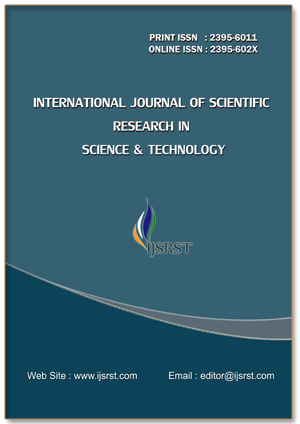Antimicrobial Activities of Herbal Plant-Dried Chamomile Flowers (Matricaria Chamomilla) Against Different Bacterial Strains
DOI:
https://doi.org/10.32628/IJSRST2512340Keywords:
Matricaria chamomilla, aqueous extract, Antibacterial activity, Anti-Susceptibility TestAbstract
The well-known medical herb chamomile (Matricaria chamomilla), often known as German chamomile, has long been utilized for its antibacterial, anti-inflammatory, and antioxidant qualities. The dried flowers of chamomile include a variety of terpenoids and flavonoids that enhance its medicinal properties. Numerous human conditions, including as hay fever, inflammation, muscular spasms, menstrual problems, sleeplessness, ulcers, wounds, gastrointestinal disorders, rheumatic pain, and hemorrhoids, are frequently treated with chamomile products. Yersinia kritensenii, Staphylococcus aureus, Salmonella, Micrococcus Luteus, Staphylococcus saprophyticus, and Serretia rubidaea were among the bacterial strains against which the antibacterial properties of an aqueous extract of dried chamomile flowers were to be ascertained. During this investigation, the following tests were performed: phytochemical analysis, antibacterial activity, antibiotic susceptibility test (disc diffusion method), and Minimum Inhibitory Concentration (MIC). Numerous phytochemicals, including alkaloids, tannins, coumarins, phenols, flavonoids, glycosides, proteins, and amino acids, have been shown to be present in this herbal extract during phytochemical examination. The study's findings demonstrated that chamomile extract has antibacterial qualities and can be utilized as an ingredient in a variety of antimicrobial medication formulations.
📊 Article Downloads
References
Srivastava, J. K., Shankar, E., & Gupta, S. (2010). Chamomile: A herbal medicine of the past with a bright future (review). In Molecular Medicine Reports (Vol. 3, Issue 6, pp. 895–901). https://doi.org/10.3892/mmr.2010.377
Boudıeb, K., Ait Slimane - Ait Kaki, S., Oulebsir-Mohandkaci, H., & Bennacer, A. (2018). Phytochemical Characterization and Antimicrobial Potentialities of Two Medicinal plants, Chamaemelum nobile (L.) All and Matricaria chamomilla (L.). International Journal of Innovative Approaches in Science Research, 2(4), 126–139. https://doi.org/10.29329/ijiasr.2018.173.2
Azari, A. A., & Danesh, A. (2021). Antibacterial effect of matricaria chamomilla alcoholic extract against drug-resistant isolates of staphylococcus aureus and pseudomonas aeruginosa. Infection, Epidemiology and Microbiology, 7(1), 29–35. https://doi.org/10.29252/iem.7.1.29.
Noshad, M., Behbahani, B. A., & Mehrnia, M. A. (2024). Evaluation of antioxidant activity, total phenol and flavonoid and antibacterial activity of German chamomile. Journal of Food Science and Technology (Iran), 21(154), 139–150. https://doi.org/10.22034/FSCT.21.154.139
Singh, O., Khanam, Z., Misra, N., & Srivastava, M. K. (2011). Chamomile (Matricaria chamomilla L.): An overview. In Pharmacognosy Reviews (Vol. 5, Issue 9, pp. 82–95). https://doi.org/10.4103/0973-7847.79103
Prakhyath, K., Mehra, P., Khatri, C., Prakash, T., Kumar, D., Padalia, R., & Yogendra, N. (2024). Improving productivity, nutrient efficiency and economics of chamomile (Matricaria chamomilla L.) using phosphate and potassium solubilizing bacteria. Fundamental and Applied Agriculture, 9(3), 143. https://doi.org/10.5455/faa.215301
Abduljabbar, A., & Aljanaby, J. (n.d.). In vitro antibacterial activity of an aqueous extracts of Matricaria chmomilla flowers against pathogenic bacteria isolated from pregnant women with urinary tract infection. www.biomedres.info
Fareed, I., & Karm, A. (2024). Benefits of Marjoram (Origanum majorana) and Chamomile (Matricaria chamomilla) in Preserving some Foods from Spoilage. https://doi.org/10.30526/37.3.3504
Shaikh, J. R., & Patil, M. (2020). Qualitative tests for preliminary phytochemical screening: An overview. International Journal of Chemical Studies, 8(2), 603–608. https://doi.org/10.22271/chemi.2020.v8.i2i.8834
Sham Shihabudeen, M. H., Priscilla, H. D., & Thirumurugan, K. (2010). Antimicrobial activity and phytochemical analysis of selected Indian folk medicinal plants. In International Journal of Pharma Sciences and Research (IJPSR) (Vol. 1, Issue 10).
Radji, M., Agustama, R. A., Elya, B., & Tjampakasari, C. R. (2013). Antimicrobial activity of green tea extract against isolates of methicillin-resistant Staphylococcus aureus and multi-drug resistant Pseudomonas aeruginosa. Asian Pacific Journal of Tropical Biomedicine, 3(8), 663–667. https://doi.org/10.1016/S2221-1691(13)60133-1
Balali, G. I., Yar, D. D., & Sylverken, A. A. (2023). Antimicrobial activities of Hibiscus sabdariffa and Aspilia africana against clinical isolates of Salmonella typhi. Scientific African, 20. https://doi.org/10.1016/j.sciaf.2023.e01667
Hikaambo, C. N., Kaacha, L., Mudenda, S., Nyambe, M. N., Chabalenge, B., Phiri, M., Biete, L. L., Akapelwa, T. M., Mufwambi, W., Chulu, M., & Kampamba, M. (2022). Phytochemical Analysis and Antibacterial Activity of <i>Azadirachta indica</i> Leaf Extracts against <i>Escherichia coli</i> Pharmacology & Pharmacy, 13(01), 1–10. https://doi.org/10.4236/pp.2022.131001
Downloads
Published
Issue
Section
License
Copyright (c) 2025 International Journal of Scientific Research in Science and Technology

This work is licensed under a Creative Commons Attribution 4.0 International License.
https://creativecommons.org/licenses/by/4.0




